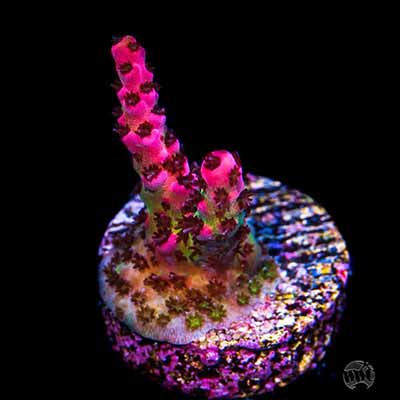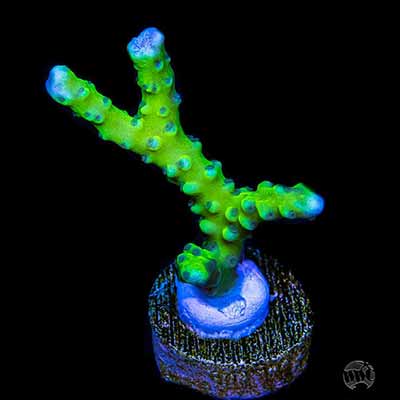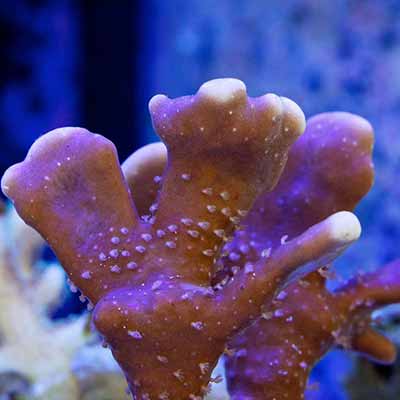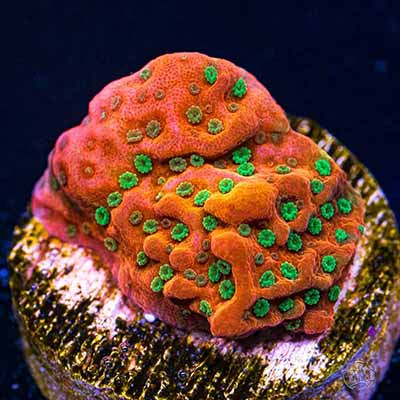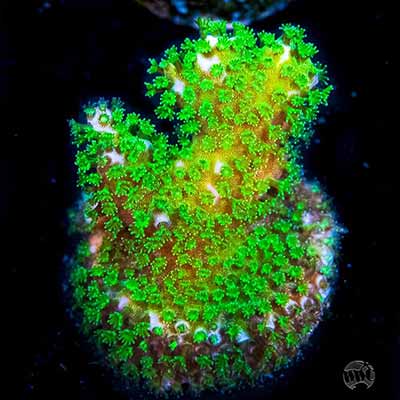If you are considering adding SPS (Small Polyp Stony) corals to your reef tank, this comprehensive care guide is for you. Small polyp stony corals are not a beginner coral type but a fulfilling challenge for advanced aquarists. LPS corals (large polyp stony) are much better suited to those that are new to reef aquariums.
You’ll find all the information you need to know before trying to add this beautiful but delicate type of coral to your reef tank.
What are SPS corals?
Small Polyp Stony (SPS) corals are a group of coral species with a stony calcium carbonate skeleton and small coral polyps. These corals are the first that come to mind when someone thinks of corals, and they are called the “true” corals because they build the backbone of the reefs and cement it together.
Even if SPS corals are the first to come to mind when someone joins the reef aquarium hobby, they are the last ones to be mastered.
Small Polyp Stony Coral Types
The most common SPS coral species are the ones ending in “pora.” Some examples are displayed below. You can find these examples are more at World Wide Corals and Tidal Gardens.
SPS Coral Care
SPS corals need a constant calcium and alkalinity level to build a skeleton. If these levels drop too low, it can compromise their structure, and they could die.
These corals also need substantial water movement, as all the tissues and polyps need to receive water flow to stay healthy.
Water parameters
These are the recommended water parameters for SPS corals.
- Temperature: 78º – 80º Fahrenheit (~ 25 – 27 ºCelsius)
- Salinity: 30-35 ppt or Specific Gravity 1.023 – 1.026 sg
- Nitrate: < 10 ppm – Can be toxic to livestock if too high
- PH: between 8.1 and 8.4
- Phosphate: < .10 ppm
- Calcium: 420-440 ppm
- Alkalinity: between 8 and 9.5 dKH
- Magnesium: 1260-1350 ppm
Dosing
Dosing is required to provide SPS corals the necessary alkalinity, calcium, magnesium, and trace elements that they need to grow. LPS and soft coral are able to get enough of these elements from regular water changes. Quality salt mixes for making saltwater contain enough of these elements for all large polyp stony and soft coral. Salt mixes can also support small polyp stonies when they are small, but eventually, you’ll need to begin dosing.
Be sure to read our article for details on dosing your reef tank for SPS corals.
Acclimation
When you add SPS corals to your tank, it is highly recommended to acclimate them from the bag of water.
Many advanced aquarists recommend the use of quarantine tanks for corals. This process is required to reduce further shock to the corals by changing environments. If you can use them, it can save you from headaches in case there are problems with pests.
When you acclimate the corals, you allow them time to adjust to the new water parameters, as SPS corals are susceptible to these changes. The biggest problems are pH, salinity, and water temperature.
Acclimation can be done in a bucket or in the bag they came in. Add half a cup of water every 30 minutes until the water has doubled in size. Then gently remove the corals, let them drip off all the water excess, and place them in the tank. Don’t forget to acclimate them for lighting as well (more details later in the article).
Don’t allow the bag water to enter your tank, as it can cause destruction and death to your system.
Some people also prefer to dip their corals to treat them of any possible pests they might have before placing them in the tank. This is done before acclimation.
Growth rate
Every coral is different, and they have different growth rates depending on salinity, water temperature, turbulence, and food availability. The massive corals grow the slowest, adding 5-25 mm (0.2-1 inch) per year. Staghorn and branching corals can grow much faster, adding up to 20 cm (8 inches) every year.
Placement
Spacing
The distance between SPS corals doesn’t have to be that big. 5-8 cm between them is more than enough. But keep an eye out for those species that grow fast.
Flow requirements
SPS corals need a lot of water movement, so it’s recommended a flow rate in the range of 40-60 gallons per hour (GPH). This number represents the number of times the water volume in the tank is moved during an hour. For example, a 200-gallon tank that has a GPH of 10,000 has a flow rate of 50x.
Lighting requirements
PAR
The PAR requirement for SPS corals is a highly debated topic in the reefing community.
The best recommendation is 250 – 350 PAR all over the tank.
Light distribution is more important than having the highest value, and sometimes lower PAR is better. Use a PAR meter to ensure there aren’t any hotspots in your tank that can burn your corals. The hotspots are not visible to the naked eye.
Light acclimation
Your corals need to adapt to the light in your system. One way to acclimate them is by starting at 50% light intensity and increasing it by 5% every 3 days until 100%.
Some modern lighting systems have a light acclimation mode you can use.
However, this method is not suitable when adding new corals to an existing system. Low lights will starve your current corals.
In this case, add new corals to darker spots inside your tank where you measure the PAR levels, and you know they are lower. Move them after 1-2 weeks in a location with more light. At the 3rd move, the corals can be placed where they should be permanent.
Feeding
SPS corals are photosynthetic, relying on their zooxanthellae to convert light into food. They also eat tiny prey with their polyps. The size of their polyps determines the size of the food they can eat.
SPS corals feed on copepods, zooplankton, marine snow, cyclops, and other minor sources of organic matter.
Another source of nutrients for SPS corals is their tank mates. Fish and other organisms like shrimps that live in the tank create a steady flow of organic matter.
How often do you feed SPS corals?
If you want to feed the SPS corals directly, there is exceptional food available at reef shops. Depending on the manufacturer, you can provide them 1-2 times a week or more often.
Best time to feed SPS corals
The best time to feed your SPS corals is after the light is out. This will ensure the best nutrient absorption for supplements and foods that you dispense directly into the aquarium.
Switch off the skimmer during feeding for about an hour.
SPS coral diseases
SPS corals are more prone to coral diseases compared with other corals because they are less tolerant to changes in water parameters.
Two common elements for all coral diseases are stress from external factors and/or changes in water parameters. The environmental factors include stress, injury from other organisms, and certain types of bacteria or fungus.
Some of the known diseases are shown below.
- Black-Band Disease.
- Bacterial Bleaching.
- Aspergillosis.
- Dark Spots Disease.
- Environmental Bleaching.
SPS coral pests
Pests can really affect your SPS corals and even kill them if they have a chance. That’s why it’s essential to know the most common pests and how to identify them.
Aiptasia Anemone
Anemones can multiply quickly and dominate a reef aquarium. They pose a threat to the tank because they sting fish and corals. Agitating Aiptasia can release eggs into the water column, spreading the infection. There are many treatments available that you can use to cover or inject this pest. There is also the option of using natural predators such as Copperband Butterfly Fish, Peppermint Shrimp, or Berghia Nudibranch.
Coral Eating Nudibranchs
They are the most difficult to see critters in your aquarium. They are tiny and take the color of the coral they are eating. Reproduction is quick, and they can decimate SPS corals.
Treatment is more tricky since eggs are resistant to coral dips, which are effective on adults. But you should still dip new corals as a precaution.
Physically removing Coral Eating Nudibranchs might be the best option. If you dip infected corals frequently, you can starve persistent infestations.
Red Bugs
Red Bugs are small crustaceans that feed on Acropora. They can have serious adverse effects on the infested coral if present in high numbers. Dragonface Pipefish can prey on red bugs, but they are challenging to keep in an aquarium.
The best method of control is removal and dipping. Preventive measures like dipping and quarantining new corals before adding them to the tank are recommended.
Bristle Worms
Bristle Worms are not a threat until the population is out of control or if they grow larger than 5”. Smaller worms can be helpful by consuming detritus, but larger specimens can attack coral, fish, and invertebrates.
The most effective way of getting rid of them is removing them. There are special Bristle Worm traps you can set, or sometimes you can grab them with a pair of tongs. Arrow Crabs, Dottyback, Wrasse, and Hawkfish are known to prey on them.
Acropora Eating Flatworms
Acropora eating flatworms prey on your Acropora corals. The best way to eliminate this pest is by treating your tank with a flatworm control solution and removing and dipping your Acropora corals.
Coral dipping, inspecting your corals, and quarantine are critical to avoid introducing this pest to your tank.
SPS coral bleaching
Coral bleaching happens when the tissue of the coral loses color or becomes translucent or white. The tissue itself remains attached to the corals. Therefore it can be reversed.
Stress from the environment is the leading cause of SPS coral bleaching. As we mentioned, SPS corals are sensitive to temperature, light, and water parameters changes.
Keep your tank parameters stable and within range to prevent bleaching.
Why are my SPS corals dying?
This is commonly called tissue necrosis, and it can be of two types based on speed. Rapid Tissue Necrosis (RTN) happens in 24 hours, and Slow Tissue Necrosis (STN) can take days or even months.
Some of the most common reasons for tissue necrosis in SPS corals are:
- Sudden change in alkalinity.
- A drastic change in salinity.
- Consistently low alkalinity levels.
- Temperature swings, up or down.
- Bacteria such as Philaster Guamense and Philaster Lucinda.
STN is challenging to stop, and RTN is almost impossible to stop. To minimize the damage, ensure that temperature, alkalinity, salinity, and pH are within the optimal range. Test daily until resolution.
Cut off the impacted areas of the SPS coral. It’s essential to stop the spread of tissue necrosis. Cut into the healthy flesh of the coral below and above the affected area.
Why are my SPS corals turning brown?
SPS corals turn brown as a result of the overproduction of zooxanthellae. As the bacteria levels increase, they block the corals’ natural pigment, turning them brown.
This is typically caused by:
- High level of nitrates and phosphates. They are a food source for zooxanthellae, resulting in overproduction.
- The constant fluctuation in tank parameters.
- Less intense lighting for new corals than their previous environment.
Keep your tank parameters stable and slowly move your new corals to increase the light intensity until they are happy.
Spawning
Most corals are hermaphrodites, as they produce both female and male reproductive cells.
Spawning involves eggs and sperm being released into the water at the same time. In nature, this happens simultaneously, once a year, depending on the moon phase. All corals in the colony release their eggs and sperm at the same time in a great spectacle.
However, spawning SPS corals in a home aquarium is a rare sight.
Small Polyp Stony Coral Polyp Extension
Polyp extension in SPS corals is mainly related to respiration needs. They need to “breathe” at night, and the polyp has the most surface area.
It’s not necessary to have a good poly extension to have success with your SPS corals, but if you want to, here are 5 tips to maximize SPS polyp extension:
- Avoid fish that tend to snack on SPS corals.
- Maintain excellent and stable water conditions.
- Provide strong random flow with an excellent recirculating pump such as EcoTech MP40.
- Provide adequate light for all types of corals.
- Keep an eye out for pests that might attack your SPS.
Are SPS corals hard to keep?
Small Polyp Stony corals can be difficult to keep, and it is recommended for new reefers to start with soft and LPS corals.
The reason SPS corals are not recommended for beginners are many:
- Very intolerant of nitrates
- Very intolerant of phosphates
- Very high lighting requirements
- Require strong water flow
- Unable to defend themselves from stings of other corals
- Very sensitive to water temperature
Why are SPS corals difficult?
SPS corals are susceptible to nitrates and phosphates, which must always be as close to zero as possible. They are also the most demanding of strong water flow and intense light, are very intolerant of warmer water temperature, and are poor at fighting off aggressive corals.
In a neglected or poorly managed reef aquarium, an SPS coral will die in days, while LPS and softies can last for months.
They need stable parameters, especially alkalinity.
SPS corals for beginners
Even when you have some experience with growing LPS or soft corals, you shouldn’t jump right into SPS. You should start with the ones that are easier to manage and are more recommended for beginners.
What is the easiest SPS coral to keep?
Montipora corals are considered the best SPS corals for beginners. They come in a variety of colors and appearances but generally have an encrusting growth style.
Montipora corals build alongside the Acropora genus around a third of the mass of coral reefs on the planet. That makes them a sustainable coral species for harvesting.
Collected frags don’t harm the mother colony as Montipora are exceptionally hardy. They are peaceful and need to be kept away from aggressive species.
Keep calcium levels high in the tank (450 ppm) as Montipora are growers and slow down when levels drop.
Are SPS corals aggressive?
SPS corals are the least aggressive type of corals and often live close together in the wild.
Because of their difference in flow, light, reef habitat, aggressiveness, and feeding, LPS and SPS corals shouldn’t be kept together.
Are SPS corals filter feeders?
Yes. SPS corals are primarily photosynthetic, depending on zooxanthellae to convert light into food through photosynthesis. But unlike algae and plants, SPS corals can also capture and eat tiny prey with small polyps. That makes them a filter feeder.
Final Thoughts
Small polyp stony corals are beautiful and challenging additions to a reef aquarium. While not recommended for the beginner reef aquarist, they’re a great new challenge for those that have already mastered large stony polyp corals and are looking to add more variety and more challenge to their existing aquarium.
When armed with the details of SPS coral care, especially reef tank dosing, you can be assured that you’ll be well prepared to begin your adventure with these vibrant and challenging corals.
